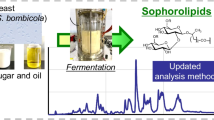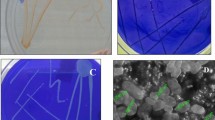Abstract
In this study, the production and physicochemical characterization of exopolysaccharide (EPS) produced by Lysinibacillus fusiformis KMNTT-10 were investigated. Also, in vitro assays were conducted to investigate the biotechnological functional activities of EPS, including flocculation, emulsification, and antioxidant activity. Results showed that the maximum EPS produced by strain KMNTT-10 was 4.19 g/l after 120 h. The monosaccharides present in EPS were xylose, rhamnose, arabinose, galactose, and glucose in varying combinations. Characterization of EPS by FTIR and XRD analysis revealed the presence of hydroxyl, amino, and carboxyl functional groups and further, the EPS is an amorphous nature. SEM envisaged a highly porous web-like structure with an irregular surface in the EPS morphology. Further, the EPS had good flocculation activity with a maximum of 89.66% and also had potent emulsifying activity towards hydrocarbons with 1% EPS concentration. The EPS showed good antioxidant activity by potent scavenging actions on DPPH, ABTS, and nitric oxide free radicals. Overall results demonstrated that EPS of KMNTT-10 could be used in various industrial applications due to its excellent flocculation, emulsification potential, and good antioxidant activity.




Similar content being viewed by others
References
More TT, Yadav JSS, Yan S et al (2014) Extracellular polymeric substances of bacteria and their potential environmental applications. J Environ Manag 144:1–25
Ates O (2015) Systems biology of microbial exopolysaccharides production. Front Bioeng Biotechnol 3:200. https://doi.org/10.3389/fbioe.2015.00200
Krishnamurthy M, Uthaya CJ, Thangavel M et al (2020) Optimization, compositional analysis, and characterization of exopolysaccharides produced by multi-metal resistant Bacillus cereus KMS3-1. Carbohydr Polym 227:115369
Rehm BHA (2010) Bacterial polymers: biosynthesis, modifications and applications. Nat Rev Microbiol 8:578–592
Orsod M, Joseph M, Huyop F (2012) Characterization of exopolysaccharides produced by Bacillus cereus and Brachybacterium sp. isolated from Asian sea bass (Lates calcarifer). Mal J Microbiol 8:170–174
Rajaram R, Banu JS, Mathivanan K (2013) Biosorption of Cu(II) ions by indigenous copper-resistant bacteria isolated from polluted coastal environment. Toxicol Environ Chem 95:590–604. https://doi.org/10.1080/02772248.2013.801979
Poli A, Di Donato P, Abbamondi GR, Nicolaus B (2011) Synthesis, production, and biotechnological applications of exopolysaccharides and polyhydroxyalkanoates by Archaea. Archaea 2011:693253. https://doi.org/10.1155/2011/693253
Kanamarlapudi SLRK, Muddada S (2017) Characterization of exopolysaccharide produced by Streptococcus thermophilus CC30. Biomed Res Int 2017:4201809
Singh RP, Shukla MK, Mishra A et al (2011) Isolation and characterization of exopolysaccharides from seaweed associated bacteria Bacillus licheniformis. Carbohydr Polym 84:1019–1026
Suppiah S, Sendeshkannan K, Prabakaran P et al (2012) Purification and characterization of alkaline protease from Lysinibacillus fusiformis. J Biochem Technol 4:561–564
Singh RK, Kumar DP, Solanki MK et al (2013) Optimization of media components for chitinase production by chickpea rhizosphere associated Lysinibacillus fusiformis B-CM18. J Basic Microbiol 53:451–460
Pradhan AK, Pradhan N, Sukla LB et al (2014) Inhibition of pathogenic bacterial biofilm by biosurfactant produced by Lysinibacillus fusiformis S9. Bioprocess Biosyst Eng 37:139–149
Mathivanan K, Rajaram R (2014) Isolation and characterisation of cadmium-resistant bacteria from an industrially polluted coastal ecosystem on the southeast coast of India. Chem Ecol 30:622–635
Acosta MP, Valdman E, Leite SGF et al (2005) Biosorption of copper by Paenibacillus polymyxa cells and their exopolysaccharide. World J Microbiol Biotechnol 21:1157–1163
Dubois M, Gilles KA, Hamilton JK et al (1956) Colorimetric method for determination of sugars and related substances. Anal Chem 28:350–356
Lowry OH, Rosebrough NJ, Farr AL, Randall RJ (1951) Protein measurement with the Folin phenol reagent. J Biol Chem 193:265–275
Arun J, Selvakumar S, Sathishkumar R et al (2017) In vitro antioxidant activities of an exopolysaccharide from a salt pan bacterium Halolactibacillus miurensis. Carbohydr Polym 155:400–406
Sathiyanarayanan G, Yi D-H, Bhatia SK et al (2015) Exopolysaccharide from psychrotrophic Arctic glacier soil bacterium Flavobacterium sp. ASB 3-3 and its potential applications. RSC Adv 5:84492–84502
Freitas F, Alves VD, Carvalheira M et al (2009) Emulsifying behaviour and rheological properties of the extracellular polysaccharide produced by Pseudomonas oleovorans grown on glycerol byproduct. Carbohydr Polym 78:549–556
Ma W, Chen X, Wang B et al (2018) Characterization, antioxidativity, and anti-carcinoma activity of exopolysaccharide extract from Rhodotorula mucilaginosa CICC 33013. Carbohydr Polym 181:768–777
Sivasankar P, Seedevi P, Poongodi S et al (2018) Characterization, antimicrobial and antioxidant property of exopolysaccharide mediated silver nanoparticles synthesized by Streptomyces violaceus MM72. Carbohydr Polym 181:752–759
Sajna KV, Sukumaran RK, Gottumukkala LD et al (2013) Studies on structural and physical characteristics of a novel exopolysaccharide from Pseudozyma sp. NII 08165. Int J Biol Macromol 59:84–89
González-García Y, Heredia A, Meza-Contreras JC et al (2015) Biosynthesis of extracellular polymeric substances by the marine bacterium Saccharophagus degradans under different nutritional conditions. Int J Polym Sci. https://doi.org/10.1155/2015/526819
Sun M-L, Zhao F, Shi M et al (2015) Characterization and biotechnological potential analysis of a new exopolysaccharide from the Arctic marine bacterium Polaribacter sp. SM1127. Sci Rep 5:18435
Gomaa M, Yousef N (2020) Optimization of production and intrinsic viscosity of an exopolysaccharide from a high yielding Virgibacillus salarius BM02: study of its potential antioxidant, emulsifying properties and application in the mixotrophic cultivation of Spirulina platensis. Int J Biol Macromol 149:552–561
Kavita K, Mishra A, Jha B (2011) Isolation and physico-chemical characterisation of extracellular polymeric substances produced by the marine bacterium Vibrio parahaemolyticus. Biofouling 27:309–317
Sardari RRR, Kulcinskaja E, Ron EYC et al (2017) Evaluation of the production of exopolysaccharides by two strains of the thermophilic bacterium Rhodothermus marinus. Carbohydr Polym 156:1–8
López-Ortega MA, Rodríguez-Hernández AI, Camacho-Ruíz RM et al (2020) Physicochemical characterization and emulsifying properties of a novel exopolysaccharide produced by haloarchaeon Haloferax mucosum. Int J Biol Macromol 142:152–162
Angelaalincy M, Senthilkumar N, Karpagam R et al (2017) Enhanced extracellular polysaccharide production and self-sustainable electricity generation for PAMFCs by Scenedesmus sp. SB1. ACS Omega 2:3754–3765
Solmaz K, Ozcan Y, Mercan Dogan N et al (2018) Characterization and production of extracellular polysaccharides (EPS) by Bacillus pseudomycoides U10. Environments 5:63
Dogan NM, Doganli GA, Dogan G, Bozkaya O (2015) Characterization of extracellular polysaccharides (EPS) produced by thermal bacillus and determination of environmental conditions affecting exopolysaccharide production. Int J Environ Res 9:1107–1116
Prasanna PHP, Bell A, Grandison AS, Charalampopoulos D (2012) Emulsifying, rheological and physicochemical properties of exopolysaccharide produced by Bifidobacterium longum subsp. infantis CCUG 52486 and Bifidobacterium infantis NCIMB 702205. Carbohydr Polym 90:533–540
Chen Z, Shi J, Yang X et al (2016) Isolation of exopolysaccharide-producing bacteria and yeasts from Tibetan kefir and characterisation of the exopolysaccharides. Int J Dairy Technol 69:410–417
Wang Y, Li C, Liu P et al (2010) Physical characterization of exopolysaccharide produced by Lactobacillus plantarum KF5 isolated from Tibet Kefir. Carbohydr Polym 82:895–903
Lobo RE, Gómez MI, de Valdez GF, Torino MI (2019) Physicochemical and antioxidant properties of a gastroprotective exopolysaccharide produced by Streptococcus thermophilus CRL1190. Food Hydrocoll 96:625–633
Garzon-Sanabria AJ, Davis RT, Nikolov ZL (2012) Harvesting Nannochloris oculata by inorganic electrolyte flocculation: effect of initial cell density, ionic strength, coagulant dosage, and media pH. Bioresour Technol 118:418–424
Roselet F, Vandamme D, Roselet M et al (2015) Screening of commercial natural and synthetic cationic polymers for flocculation of freshwater and marine microalgae and effects of molecular weight and charge density. Algal Res 10:183–188
Lemanowicz M, Gierczycki A, Al-Rashed MH (2011) Dual-polymer flocculation with unmodified and ultrasonically conditioned flocculant. Chem Eng Process Process Intensif 50:128–138
Okaiyeto K, Nwodo UU, Mabinya LV, Okoh AI (2013) Characterization of a bioflocculant produced by a consortium of Halomonas sp. Okoh and Micrococcus sp. Leo. Int J Environ Res Public Health 10:5097–5110
Yang M, Liang Y, Dou Y et al (2017) Characterisation of an extracellular polysaccharide produced by Bacillus mucilaginosus MY6-2 and its application in metal biosorption. Chem Ecol 33:625–636
Biswas JK, Banerjee A, Sarkar B et al (2020) Exploration of an extracellular polymeric substance from earthworm gut bacterium (Bacillus licheniformis) for bioflocculation and heavy metal removal potential. Appl Sci 10:349
Kielak AM, Castellane TCL, Campanharo JC et al (2017) Characterization of novel Acidobacteria exopolysaccharides with potential industrial and ecological applications. Sci Rep 7:1–11
Zhong Q, Wei B, Wang S et al (2019) The antioxidant activity of polysaccharides derived from marine organisms: an overview. Mar Drugs 17:674. https://doi.org/10.3390/md17120674
Liu J, Luo J, Ye H et al (2010) In vitro and in vivo antioxidant activity of exopolysaccharides from endophytic bacterium Paenibacillus polymyxa EJS-3. Carbohydr Polym 82:1278–1283
Abdhul K, Ganesh M, Shanmughapriya S et al (2014) Antioxidant activity of exopolysaccharide from probiotic strain Enterococcus faecium (BDU7) from Ngari. Int J Biol Macromol 70:450–454
Yan J-K, Wang W-Q, Ma H-L, Wu J-Y (2013) Sulfation and enhanced antioxidant capacity of an exopolysaccharide produced by the medicinal fungus Cordyceps sinensis. Molecules 18:167–177
Ayyash M, Abu-Jdayil B, Olaimat A et al (2020) Physicochemical, bioactive and rheological properties of an exopolysaccharide produced by a probiotic Pediococcus pentosaceus M41. Carbohydr Polym 229:115462
Min W-H, Fang X-B, Wu T et al (2019) Characterization and antioxidant activity of an acidic exopolysaccharide from Lactobacillus plantarum JLAU103. J Biosci Bioeng 127:758–766. https://doi.org/10.1016/j.jbiosc.2018.12.004
Boora F, Chirisa E, Mukanganyama S (2014) Evaluation of nitrite radical scavenging properties of selected zimbabwean plant extracts and their phytoconstituents. J Food Process 2014:918018. https://doi.org/10.1155/2014/918018
Acknowledgements
We would like to thank major research of “Mechanism underlying elemental cycling on the earth by microorganisms in hydrosphere” (Grant No. 91851206) launched by NSFC and the National Nature Science Foundation of China (NSFC: Grant No. 41877345). The Postdoctoral research plan at Central South University for K. Mathivanan is gratefully acknowledged. We wish to thank the Hunan International Scientific and Technological Cooperation Base of Environmental Microbiome and Application [2018WK4019] for funding the research.
Author information
Authors and Affiliations
Contributions
MK: conceptualiation, Investigation, Methodology, Data curation, Writing-original draft. JUC: formal analysis. AV: data curation. RKG: formal analysis. DM: validation. HY: conceptualiation, funding acquisition, resources, and supervision.
Corresponding authors
Ethics declarations
Conflict of interest
The authors declare that they have no conflict of interest.
Research Involving Human and Animal Rights
This article does not contain any studies with human participants or animals performed by any of the authors.
Additional information
Publisher's Note
Springer Nature remains neutral with regard to jurisdictional claims in published maps and institutional affiliations.
Rights and permissions
About this article
Cite this article
Mathivanan, K., Chandirika, J.U., Vinothkanna, A. et al. Characterization and Biotechnological Functional Activities of Exopolysaccharides Produced by Lysinibacillus fusiformis KMNTT-10. J Polym Environ 29, 1742–1751 (2021). https://doi.org/10.1007/s10924-020-01986-3
Accepted:
Published:
Issue Date:
DOI: https://doi.org/10.1007/s10924-020-01986-3




